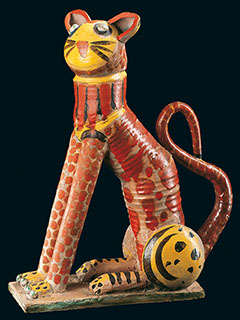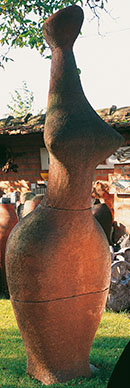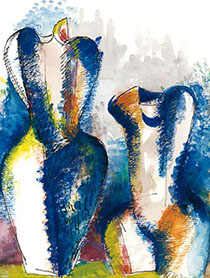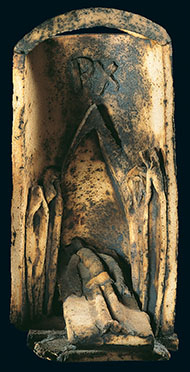ÁRPÁD CSEKOVSZKY
The oeuvre of every artist is always determined by the age, place and time of their life. In addition to these, the roots and traditions are also very important here in Hungary. The mother tongue and cultural background is still determinant even in the age of globalization. Family, friends and school escort the human beings from cradle to grave, they imprint into their soul together with the features of their native soil. These yarns formulate the artist’s personality, his interests and ambitions. Their importance has different intensity at different periods.
The demand for the unique pieces of fine workmanship was created in England by the pre-Raphaelite movement and with the guidance of J. Ruskin as a reaction to the technical, technological and industrial revolution of the previous century. Their creative efforts soon gained popularity and after the displays at Expos at the end of the 19th century they were quickly spreading in the USA as well. There, even today, are different art studios following this trend connected to certain universities.
Ceramics became the leading branch of handicrafts. It was the first branch of art to unite in harmony the increasing interest of modern people in chemistry and technology with the new artistic ambitions. The leading European pottery factories - such as Royal Danish Porcelain in Copenhagen, and also the Danish Bing & Groendahl, the English Milton, the Swedish Sévres, the German Meissen, the Hungarian Zsolnay, the French Theodor Deck and the Danish Arnold Krogh - and their designers were feverishly searching for and experimenting with new materials for pottery and glazing. In parallel, the traditional materials and technologies were more and more improved.
After the great prosperity at the end of the 19th century and then, after World War I the political, economical and cultural map of Europe was redrawn. The important artistic centres of Middle Europe closed down in Germany and Austria, and France took over their roles with the dominance of Paris. The history and development of the Hungarian craftsmanship was traditionally connected to Austria and Germany. Their most important centres were the Wiener Werkstatte and Munich. István Gádor’s oeuvre was connected to Vienna, while Margit Kovács, the youngest member of the ’great triad’ of the age, started her studies in Munich and Vienna. However, there was no real demand for the fashionable unique artistic ceramics neither in Austria nor in Hungary, partly because of their high price and also because of the very thin social layer of the middle class. Their works of arts could appear mostly displayed in exhibitions. The market was dominated by the mass products of the Zsolnay ceramics factory and the china manufacture of Herend. Later, when the new social classes started to boom in the 1930s, Hitler came into power and then World War II broke out, so claim for an exquisite decoration of the homes faded again.
Among these social and economical circumstances the heroic attempts of some artists to live for their vocation seem to be a miracle.
One of them was István Gádor (1891 – 1984), an outstanding personality of the Hungarian art of pottery, whose mind was receptive to accept and try out any new ideas and trends until his death. He was also the mentor and instructor of generations with his humble, serious and exemplary character. During his long life spent in privation, he was acknowledged with all the Hungarian awards, titles and medals but not with proper commissions, although his posthumous pieces in his studio still have some valuable solutions even to the gigantic challenge of the modern age. He burst into the colourful world of ceramics during the First World War. Then, the Hungarian art of pottery emerged from the obscurity of the post-war period and met with success in several exhibitions. The attention of the small number of patrons of the arts with small resources turned towards our ceramists and also a need for artistic pieces of interior design appeared in the second half of the 1920s. A new movement of style was initiated by the group of artists centred round Lajos Kozma, the interior designer. It was the Hungarian Art Deco which, having its roots in old Hungarian motives and folk traditions, was aimed at creating a modern wave of decorative arts.
Gádor’s statuettes preserved the influence of the style of African figurines then fashionable also in Vienna. A small collection of his works was displayed at the Biennale in Venice and in 1926 they were awarded with golden medal at the World Exhibition in Barcelona. His individual style became more and more distinct to the end of the 1920s. From 1927 he turned towards Hungarian folklore and folk art and started a wide-range collecting activity and, as a result of it, he also applied the rich treasury of forms of the rural potters in his work. This tendency is represented by birds and flower compositions on his bowls and vases and he even designed a genre scene of a country fair (Debreceni vásár, 1935) built up from earth ware tiles. He also modelled small figurines of characteristic rural people.
His activity unfolded entirely after World War II. From the late 1940s he turned to new, organic forms. He was continuously experimenting with new materials, among them the fire clay. Till the very end of his life he was capable of renewal and was working with the most up-to-date forms and materials. In his late seventies he designed constructive three dimensional compositions from insulating porcelain elements which were suitable for standardised production. He also created entirely new abstract compositions applying wires and cloisonné enamel on his bowls.
In Hungary reconstruction and rebuilding started rapidly after the ruins had been cleared up. However, the development of arts was determined by the Communist party during the period of Cold War by forcing its direction towards the national forms. Nevertheless, after the foundation of the Academy of Arts and Crafts and its Department of Ceramics, whose head was István Gádor, a new generation of artists was swarming towards the big building projects and the most talented of them soon gained an outstanding role there.
István Gádor, Géza Gorka and Margit Kovács, the great triad of Hungarian ceramists, who had raised Hungarian ceramics to European rank, were in their prime. They were still active, nevertheless, the demand for monumental pieces urged also the newer generation to take an active part in design. At the same time smaller, more intimate ornamental pieces were required for the flats of the big building estates.
These two directions influenced the works of our ceramic artists. Some of them, as Árpád Csekovszky, worked in both fields but there were others, who only followed either of them.

Géza Gorka (1894-1971), the founder of this ceramist dynasty, was one of the latter. His works gained great success at exhibitions at home and internationally as well. His style was continuously varied as a result of the different alloyage of glazing and the base material of clay. On his later pieces he gave up decoration, however, his „springing”, cracking varnish gave them unique beauty. A pupil of his, Lívia Gorka, distinguished herself by her original talent in the field of interior figurines.
The joy to express grotesque intimacy, playfulness and lovability, characterizes the life work of Ilona Kis Róóz (1920), the doyen of contemporary ceramists.
The fruit of Gorka’s, Gádor’s and Kovács’ creative genius, with which they attained independence for ceramic arts, was harvested by a generation of their pupils and followers. Among them was Árpád Csekovszky (1931-1997), one of the outstanding masters of modern Hungarian ceramists. His characteristic, subjective way of seeing things and manyfolded sense for forms formulated quite early. His personality and morality was reflected in his works and also in his pedagogical activity and so left his marks on the world view of the following generations.
His plastic art had been formulating from different sources before the1970s when he started to create his tectonic crosses and crucifixes. In these he wanted to express, besides their symbolic religious message, the rhythm, the connection and interference of the individual elements.
In addition to modelling the clay, he succeeded to gain new forms to express the increasing tense of rhythm and repetition- the everlasting problems of fine arts – in his various „charioteer” series. He was struggling with the theme of the connection between people and horses, horses and the chariot, the horse and the charioteer from the 1960s.
He was working continuously from morning to night. His only interest lay in his works.
He prepared a lot of sketches for his works focussing his imagination on sculpturesque expression. He sometimes declared himself as a painter and other times as a sculptor. He was convinced that both these arts must be present in ceramics. His strong talent for sculptures, which determined his further development in the direction of architecture and other supplementary arts, appeared in his early academic years.
Csekovszky was born in Csikóstöttös, county Baranya, on 3 January, 1931. His mother brought him up alone and he had a very poor and hard childhood. They could get some help only from László Kocsis, his uncle on his mother’s side, who was a poet and also a Roman Catholic canon and rector of the basilica of Pécs from 1950 till his death in 1973. He was the one, who helped his nephew study in the famous Grammar School of the Premonstrant Fathers in Gödöllő. He also spent his holidays at his uncle’s in Pécs, in the building of the chapterhouse of the basilica. The atmosphere of the cathedral is a constant source of inspiration thorough his oeuvre. Csekovszky’s deep Christian morality appeared in his sketches of the basilica of Pécs and also in his cubistic crucifixes, which were characteristic only of him at that time. It got even more emphasis in his later works representing scenes of Christ’s excruciation. After World War II he enrolled into the Budapesti Szépmíves Líceum (Secondary School of Fine Arts) where he took his matura exams in 1950. He wanted to be a painter but he was not accepted to the Fine Arts College, so he enrolled to the Academy of Arts and Crafts, to the Ceramics Department and became a pupil of Gádor István. He got his diploma in 1956 with outstanding result. At that time the students of ceramics and porcelain designers, gold and silversmiths all belonged to the Department of Decorative Sculpture. The head of the department was Miklós Borsos, who was greatly admired by the students and he was an outstanding artist with a European outlook.

At that time the Academy of Arts and Crafts represented a higher artistic standard than the Fine Arts College. It had several reasons, among them were also some political ones. As the strict Zsdanovian disciplines were not applied so rigorously on applied arts, the masters, who had a long artistic history and European outlook, transferred this more open mentality to their pupils. Also some social changes raised other demands. The formation of the modern Hungarian applied arts was in the hands of well-known masters who had great technical and artistic knowledge. The rectors of the College, Gyula Hincz and Frigyes Pogány were the mediators of the most up-to-date European trends and they also demanded the Heads of the departments to follow them. Besides, the cultural policy dictated by Endre Aczél interfered less with the life of the industrial artists than with that of the the writers’. Although travelling abroad was not possible during the period of Cold War the supply of books and periodicals in the library of the College was satisfactory. The artist could not appear personally in the significant international exhibitions but their works could represent the country and so they could win many outstanding prizes and they could compare their results at the major all-Hungarian shows.
For Arpád Csekovszky the period of learning came to end quite early around 1960. However, his researches and experiments with new techniques, materials and different ways of moulding kept him interested till his death. This interest was also motivated by his more than 40 years of teaching career. After István Gádor’s resignation he got the mandate to lead the Ceramics Department as a docent, as he was never nominated a full time professor because of his clerical world view. In 1985 he was dismissed for he „was not suitable” for the new „reformative spirit” .The title of „titular professor” was awarded him after his retirement in 1992.
His strict morality excluded him from joining any political movements. He was not interested in either rank or power. He looked at his teaching job as a service and he did not take part in any public intriguing or struggles. His only ambition was to put forth his art as much as possible. He was well-informed in the traditions and modern trends and also familiar with the history of ceramics. Beyond the traditional moulding of objects, he was especially interested in the correlation between ceramics and architecture. His investigations in this field were fully supported by Hincz and Pogány. He also respected his pupils’ individual tone and encouraged their freedom in experimenting.
Besides teaching he concentrated on his creative activity. All his remaining time he spent working in his studio, which he had built in 1962.He used mostly chamotte for his sculptures, although in his early period he also made glazed ceramics, not only sculptures, but also vast idols, which were assembled from clay strips. These were regarded as revolutionary novelty at that time.
His first two idol sculptures were modelled in 1961. The bigger one (180 cm tall) was the most important piece on display of the exhibition in Fényes Adolf Gallery. Nobody had made idols besides him at that time.

In his mature pieces one could notice the traces of early Greek and Etruscan traditions. Csekovszky was always interested in the very early stage of different artistic periods and not in the fully mature, classic phases. Perhaps the only exception is a terracotta relief he modelled in 1956.It is a lyric portrayal of a girl sitting in Greek clothes and weaving. (Szövő lány, 1956). But even there the robust thighs and arms of the girl rather embodies the force of nature than some the classic ideal of forms. This sculpture was inspired by Miklós Borsos’ idea of the Pannonian beauty.
Csekovszky modelled several times the unvarnished constructive figures of mature and totally simplified figures of charioteers and fighters having been inspired by Etruscan sculptures. First he raised the problem in smaller scales and without any glaze. Despite their small size they express great strength and energy. Later, the rhythm became more and more emphasized on them. They always created a great stir at different exhibitions. An outstanding piece of the exhibition in 1962 was the Charioteer (Kocsihajtó).
The artist got a silver medal at the AIC World Exhibition in Prague in 1962 and after the display of his works in the Fényes Adolf Gallery he was given Munkácsy Award.
He was mostly influenced by Cubism. Cubism had a great influence on the sculptural arts of the period. (Archipenko) and it is still an influential factor in the Hungarian fine arts due to the works of János Kmetty, Jenő Barcsai and their followers. Csekovszky was one of the most sensitive Hungarian artists to the Cubist ideas.
Drifting away from classical perspective he formulated a new configuration that was characteristic of his mature works and also, on the basis of his experiments he summed up forms in geometrical figures. Besides cubism, one can also observe in his works the stylized elements of level surfaces and configurations fused in the new coherence of constructivism.
Csekovszky was interested in one of the principal themes of prevailing sculptural arts, namely the female body mostly in the form of idols, according to the ideal of the current trends. The headless female body bearing different messages in its undulating lines appeared in his art at a very early period and was present in different size and reinterpretation till his death. The extent of its abstraction was, depending on the cutting across the figure, defined by the outermost point which can still provide the notion of reality.
The mild rhythm of the female form and its enlacement temptation to touch its surface does not have erotic hints even in the series of the buoyant sketches he prepared for these idols. However, Henry Moore’s, who was the signpost of modern sculptural arts, influence glimmers through them. But Csekovszky’s idols and female torsos were also formulated into vessels and vases. He gave his attention to the changing influence of chiaroscuro and how the positive and negative forms echo to each other. In 1967 the exhibition of Henry Moore’s sculptures in the Art Gallery of Budapest brought a new inspiration to reassess the artists’ several-decade struggle with problematic forms. The shocking effect of his bulky works of art threw their spectators, as well as the contemporary artists, into fever in Hungary likewise in all around Europe.

In the 1970s Csekovszky turned back to his idols in such small sketches as the Barokk vázlatok (Baroque sketches, 1978) or the lyrical, diagonally constructed Nike (1978). These might have been the forerunners of the later pieces like the Split Idol from 1986, which is nearly one meter tall. The Leaning Idol from 1984 is almost tectonic and one of his most outstanding pieces is the Red Idol with its undulating soft forms.
The mass rhythm of the idols is always different; the transition of the polished and rough surfaces, the different effects of light and shadow, the way their tight and breast are tilted do not only give their rhythm but also lend liveliness to the headless and armless torsos. The first of these types of idols, which radiate some Mediterranean spirit, were created by Miklós Borsos under the influence of Brancusi.
The undulating line running along the twisted figure is a structural feature. It can be followed in his sketches how it formulates from the natural forms through the different phases of abstraction. A piece of this group is the terracotta Idol, made in 1978, which has a deep, plastic cut from its breasts to its loin. It is a rare expression of eroticism in Csekovszky’s works of arts; however, it had frequent manifestation in the European sculptures of the age. The perfect modelling of the sculpture formed into a vessel from beautiful strips and the deep message of the cut through above the breast express fertility. These pieces of art demonstrate Csekovszky’s gift in creating symbols. The Red Idol (1980) is a lyric formation of female beauty and fertility while the Leaning Idol (1984) with its overemphasized archaic symbols of feminity abstracts Moore’s forms of rounded pebbles and subdued stones into the gigantic forms of an ancient progenitor. The characteristics of cubism were built in the conception of the hardly noticeable breasts and robust tights of the Stepping Idol (1986), but the daring cut throughs of the Split Idol, which was made in the same year, stress the powerful structure of positive and negative forms again.

The other symbol being constant in the last period of his work is the cross, the symbol of faith. His last, summative period of his life started in the years of 1970s. He was always faithful to his upbringing and never became a heretic. During the hard times he had suppressed his religious feelings deep in himself but from the years of 1970s the monumental, dramatic crosses appeared more and more frequently in an increasingly higher technical perfection in smaller and bigger terracotta sculptures. His childhood reminiscences are echoed in his series titled Cross-bearers (Keresztvivők, 1975) and Leaning Crosses ( Dőlt Keresztek, 1976). Both of them are richly interwoven by Christian mysticism.
Religious topics, especially Christ’s excruciation came in the foreground of his work. But the forms and measures changed. Perhaps these small sized compositions were modelled only to raise some problems. Still, their modelling is quite different as they are composed from terracotta tubes and cylinders, the heads are only marked and the movements are very suggestively summed up. The praying apostles are standing under the cross with their wide gowns on a 30 cm high variation of The Crucified (Megfeszített), which was made in 1993.This, being a suggestively powerful piece, is a rare lyrical representation in Csekovszky’s oeuvre, as well as the small sized niche relief, the Sepulchre of Christ (1993). This latter one shockingly recalls the atmosphere of the site of the Holy Sepulchre in Jerusalem. Its bigger size copy can be seen in the International Ceramics Studio in Kecskemét.
The Roman horsemen of The Crucifiction (1994) strongly express the sweeping and powerful rhythm so characteristic of his works. The foreground scene, the crucifixion of Christ lying on the ground, is effectively counterbalanced with the martial horsemen lining up both sides.

He kept being interested in modelling horses and horsemen from his early youth and he moulded them in all his creative periods. Among the many variations of the theme the most important piece is the energetic Charioteer (1962), which won a silver award at the World Exhibition in Prague. It also had a strong influence on his contemporaries. He moulded a composition of the fusion of horse and horseman from chamotte. This was one of his most powerful constructivist works, from the basic principle of which he never turned away. In his later works this conception was repeated several times with several connected charioteers, either with the marking of wheels to indicate speed or without them. He also linked up his childhood memories with the representation of horsemen in the high relief titled Capturing Pécs (1994). There in the foreground of a bustling battle scene Turkish horsemen can be seen as they are besieging the walls of the fortress around the Cathedral of Pécs. This theme frequently appears in his sketches and paintings, always in constructivist style and with the reminiscences of the Cathedral of Pécs.
